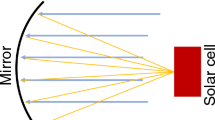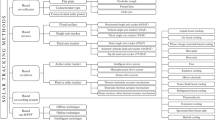Abstract
Powered by solar cells, CPV has an advantage over non-concentrated photovoltaics as it requires fewer large solar cells for the same intensity output. Besides the duration and intensity of sunlight, the temperature also affects the overall performance of PV modules. This is because excessive temperatures will significantly reduce the output power. This research paper describes practical ways to improve the overall performance of solar panels using the valuable resource of using mirrors and cooling mechanisms. These reflectors are inexpensive, easy to install, and require no machinery or equipment to install. However, the CPV works effectively in concentrated light as long as the solar cell is kept cool by the heat sink. Experimental results show a significant improvement over the traditional sun panel output.
Access this chapter
Tax calculation will be finalised at checkout
Purchases are for personal use only
Similar content being viewed by others
References
Luque A, Hegedus S (2011) Handbook of photovoltaic science and engineering. Wiley 2(2):461–478
Hahm J, Baek J, Kang H, Lee H, Park M (2015) Matlab-based modeling and simulations to study the performance of different MPPT techniques used for photovoltaic systems under partially shaded conditions. Int J Photo Energy 20(3):10
Hlin C, Hsieh WL (2012) Optimization of photovoltaic penetration in distribution systems considering annual duration curve of solar irradiation. Power Syst 27(2):1091–1097
Brogren M (2004) Optical efficiency of low-concentrating solar energy systems with parabolic reflectors. Doctoral Thesis 3(3):761–765
Swanson RM (2000) The promise of concentrators. Prog. Photovoltaics: Res Appl 8(1):93–111
Farhana Z, Irwan Y, Azimmi R, Razliana A, Gomesh N (2012) Experimental investigation of photovoltaic modules cooling system. Symp Comput Inform 165–175
Author information
Authors and Affiliations
Corresponding author
Editor information
Editors and Affiliations
Rights and permissions
Copyright information
© 2023 The Author(s), under exclusive license to Springer Nature Singapore Pte Ltd.
About this paper
Cite this paper
Patil, V. et al. (2023). Increase in Solar Panel Efficiency by the Use of Easy Mirror and Cooling Gadget. In: Vasudevan, H., Kottur, V.K.N., Raina, A.A. (eds) Proceedings of International Conference on Intelligent Manufacturing and Automation. Lecture Notes in Mechanical Engineering. Springer, Singapore. https://doi.org/10.1007/978-981-19-7971-2_62
Download citation
DOI: https://doi.org/10.1007/978-981-19-7971-2_62
Published:
Publisher Name: Springer, Singapore
Print ISBN: 978-981-19-7970-5
Online ISBN: 978-981-19-7971-2
eBook Packages: EngineeringEngineering (R0)




